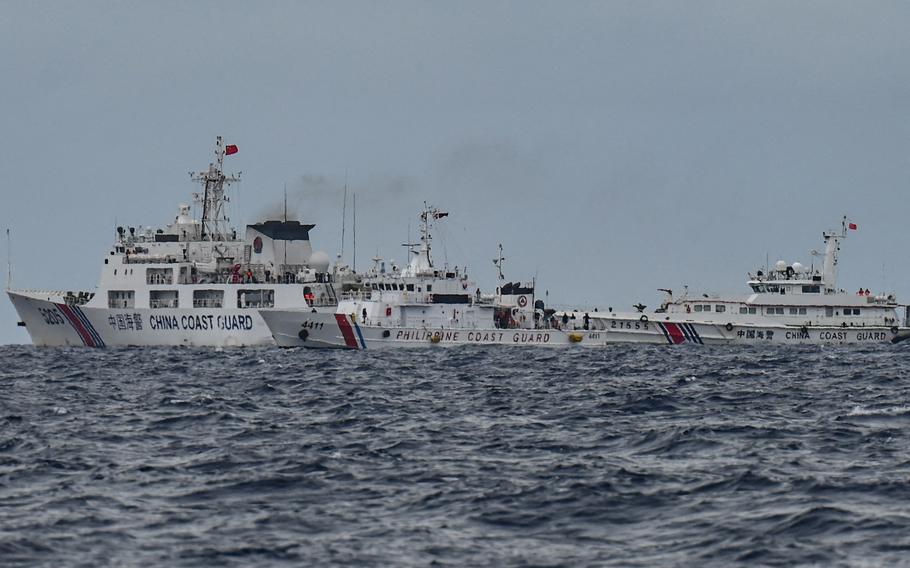
China Coast Guard ships, background left and right, are seen past the Philippine Coast Guard ship BRP Cape Engano, middle, as photographed from the BRP Cabra during a supply mission to Sabina Shoal in disputed waters of the South China Sea on Aug. 26, 2024. (Jam Sta Rosa, AFP via Getty Images/TNS)
(Tribune News Service) — The latest clashes in the tense South China Sea feature China’s coast guard wielding knives and an axe, firing water cannons and ramming Philippine vessels.
The hostilities between China and the Philippines continue to draw global attention though other Asian countries also stake claims on the resource-rich seas. A new flashpoint has opened between the two nations recently — the Sabina Shoal — just weeks after Beijing and Manila agreed to ease tensions in another hot spot.
The developments raise the stakes for the U.S., which is treaty bound to help defend the Philippines from any armed attack in the South China Sea. Washington could find itself dragged into a direct conflict with Beijing, making the South China Sea, at times more dangerous than the Taiwan Strait, observers say.
“Philippine-China strategic relations boil down to a cold war that may turn to a hot war if mishandled,” said Chester Cabalza, who heads a Manila-based security think tank.
Why are tensions rising now?
The Philippines’ maritime strategy has seen a dramatic shift under President Ferdinand Marcos Jr. who took office in June 2022. Marcos discarded his predecessor Rodrigo Duterte’s non-confrontational approach in the South China Sea and has become more assertive, backed by the U.S.
Marcos granted the U.S. military access to more Philippines bases, including those facing the South China Sea and Taiwan in early 2023, much to Beijing’s chagrin. The Philippines also increased missions in the disputed waters, including resupplying the country’s lone outpost, a dilapidated World War II-era ship which has been fortified, after years of worry that it would fall apart. China, which claims much of the waters for itself, has been trying to block these missions and assert its expansive maritime claims. These have led to more frequent — and increasingly violent — clashes, which the Philippines publicizes. That’s a strategy that Beijing has recently adopted. The encounters have caused damage to Philippine vessels and crew injuries.
Both nations tried to ease tensions around the Philippines’ military outpost in Second Thomas Shoal through a pact, only to have the clashes shift to nearby Sabina Shoal. The airspace over the disputed sea is also a site of hostilities.
What has China said?
China claims almost the entirety of the South China Sea where it has built numerous artificial islands. Beijing maintains that its actions are lawful and within its rights. Beijing’s claims overlap with the Philippines’ 200-nautical mile exclusive economic zone, which Manila calls the West Philippine Sea. Brunei, Malaysia and Vietnam also lay claim to parts of the waterway.
China has repeatedly blamed the Philippines for instigating maritime encounters and has accused Manila of ignoring its warnings. The Philippines is being emboldened by “external forces,” according to Beijing, in an apparent swipe at the U.S. Manila had branded China’s remarks as disinformation.
A particular point of contention for China was the regular Philippine convoy to provide food and other supplies to personnel on the grounded World War II-era ship in the Second Thomas Shoal. Mutually suspicious of each other’s motives, the two nations have since moved on to accusing one another of trying to establish a permanent presence in the nearby Sabina Shoal.
How did the U.S. react?
The U.S. has criticized Beijing for its South China Sea actions, repeatedly blasting its “escalatory” moves. At the same time, Washington has assured the Philippines that it will come to its defense in case of an armed attack, as stipulated in the nations’ decades-old treaty. President Joe Biden has also boosted defense funding and pledged investments to the Philippines as Washington seeks to counter China in the region.
Stronger ties with the U.S. have opened up other deals for the Philippines. Marcos has also entered into a key defense pact with Japan, and is aiming to forge a similar one with France.
The Philippines has held joint patrols with U.S. and Australia in the disputed sea, and is considering holding similar exercises with other countries.
Could this lead to war?
Though the collisions at sea have become more frequent, the rhetoric from China and the Philippines suggest that neither is prepared to take the region to the brink of war.
After meeting with President Xi Jinping on the sidelines of the Asia-Pacific Economic Cooperation Summit in November, Marcos said: “I do not think anybody wants to go to war.”
The Philippine leader suggested a higher bar for invoking a defense pact with the U.S.: the death of a Filipino soldier in the event of a foreign attack that triggers the two countries’ mutual defense treaty.
What’s next?
The Philippines plans to continue its missions in the contested waters, with Marcos saying that skirmishes with China have steeled his nation’s determination to defend its sovereignty. A U.S. military official has said Washington can escort Philippine vessels during resupply missions in the South China Sea.
Manila is also exploring diplomatic and legal steps to respond to China’s actions, including protests and another potential arbitration case.
China doesn’t intend to back down either. Beijing said it will continue asserting maritime claims, opening the possibility for more encounters at sea.
©2024 Bloomberg L.P.
Visit bloomberg.com.
Distributed by Tribune Content Agency, LLC.